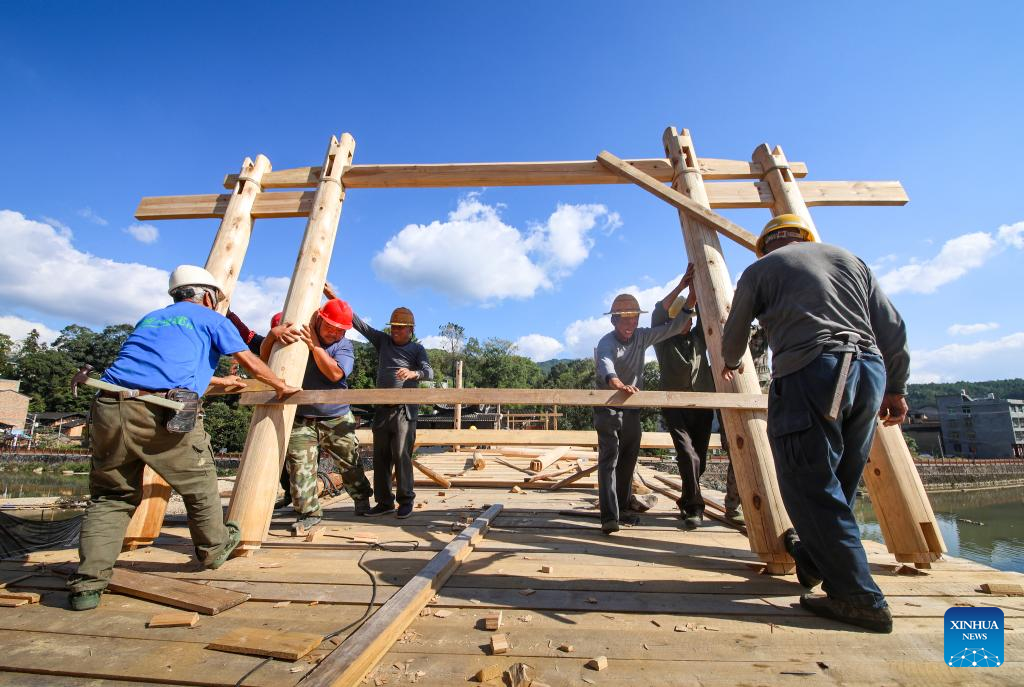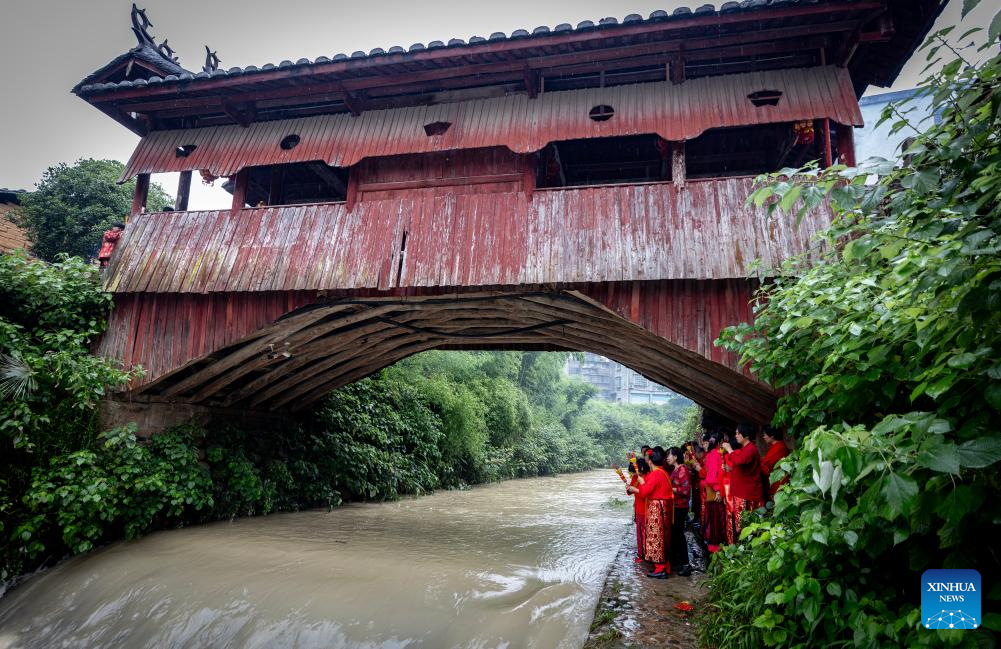
A drone photo taken on Aug. 18, 2022 shows the Rulong Bridge, a wooden arch bridge, in Qingyuan County of Lishui City, east China's Zhejiang Province.(Photo by Wu Chunping/Xinhua)
BEIJING, Dec. 6 (Xinhua) -- Hu Junfeng takes pride in using his civil engineering skills to document the wealth of knowledge his father has amassed over four decades on building Chinese wooden arch bridges.
Traditional design and practices for building Chinese wooden arch bridges were added Thursday to its Representative List of Intangible Cultural Heritage of Humanity by the United Nations Educational, Scientific and Cultural Organization (UNESCO).
The wooden arch bridges, found mostly in eastern China's Fujian and Zhejiang provinces, are built without a single metal nail or rivet. Instead, they rely solely on intricately fitted wooden structures. A traditional Chinese-style timber superstructure tops the bridge, featuring a grand roof that adds weight and bolsters the structure's stability.
According to UNESCO, the traditional design and practices for building these bridges involve the use of wood and traditional architectural tools, and they combine craftsmanship, the core technologies of "beam-weaving" and mortise and tenon joints, as well as an experienced woodworker's understanding of different environments and the necessary structural mechanics.
"This signifies that the protection, inheritance and promotion of China's traditional wooden arch bridge craftsmanship have gained global recognition," said Hu Junfeng's father Hu Miao, who has dedicated over 40 years to preserving the traditional skill.
Hu Miao, a national-level representative inheritor of the traditional wooden arch bridge construction skills, was born into a family of carpenters.
Hu Miao said that they constructed and renovated 25 such bridges. His craftsmanship attracted his son, who had previously worked in Shanghai for three years, to return to Qingyuan County, Lishui City of Zhejiang Province in 2022 to inherit the skills.
Wooden arch bridges serve as hubs for gatherings, entertainment, trade and other social activities. Locals often hold events like weddings, funerals and birthdays on these bridges.
"During the Dragon Boat Festival, locals believe that the more times one crosses the bridge, the more prosperous their life will become, expressing hope for the future," said Lu Zeqi, an intangible cultural heritage expert in Pingnan County, Ningde City of Fujian Province.
Hu's family is part of a thriving bridge conservation community in Zhejiang. The province now hosts 11 teams dedicated to wood arch bridge craftsmanship, comprising over 170 members. They have constructed and restored more than 80 such bridges.
First inscribed in 2009 on the List of Intangible Cultural Heritage in Need of Urgent Safeguarding, the tradition had declined over the years due to rapid urbanization, scarcity of lumber and lack of available construction space, all of which could threaten its transmission and survival, according to UNESCO.
In 2016, Typhoon Meranti ruined three wooden arch bridges in Zhejiang. It served as a reminder to the public of the importance of protecting and restoring these treasures, and the need to pass down the craftsmanship of bridge building.
Zhejiang has established a themed museum, included information on the bridges in primary school curricula, organized academic seminars, and produced TV documentaries to showcase the history, craftsmanship and culture of the bridges.
"UNESCO's recognition marks a transition from 'endangered' to 'revival' for the craft, signifying an endorsement of our conservation efforts," said Chen Huawen, a professor at Zhejiang Normal University.
Gabriella Bonino, an Italian sinologist, said she once visited craftsmen behind wooden arch bridges, feeling the depth of their traditional skills and admiring the way these arts are inherited through generations. The reflection of local customs is valuable and should be recognized globally.
Suman Prasai, a Nepali student at Lishui University, once learned about the building of wood arcade bridges from the Hu family in October. He told Xinhua that "knowing that these skills are now safe and will continue for future generations makes me feel proud and hopeful. It's a big success for preserving culture in today's fast-changing world. Walking across it, I could feel the connection between art and nature."
"UNESCO's recognition shows how much effort has been made to protect and pass down the traditional skills of building Chinese wooden arch bridges. These bridges are not just for crossing. They carry stories, history, and amazing craftsmanship," said Prasai.
Apart from being a source of livelihood for woodworkers, the bridges, along with the traditional techniques and knowledge used to build them, have boosted the development of relevant cultural and creative industries.
"I've enjoyed making 'wooden arch bridges' with chopsticks since childhood. Amazingly, with just 15 chopsticks, I could build a 'bridge' capable of supporting more than 1 kg," said Hu Junfeng.
Now the chopsticks have been transformed into 3D puzzles and models, as well as other cultural and creative products, showing customers the structure and techniques of bridge building.
"Wooden arch bridges, iconic symbols of China's architectural arts, reflect the essence of master craftsmanship and have turned into popular tourist destinations. With the AI technology, we can create featured products and immersive experiences that go beyond the bridges themselves," said Chen Shaofeng, a Peking University professor and vice head of the China Culture Promotion Association. ■

This stitched aerial drone photo taken on Jan. 23, 2024 shows the Wan'an Bridge, a wooden arch bridge, in Changqiao Township of Pingnan County, southeast China's Fujian Province.(Photo by Wang Zhiling/Xinhua)

This photo taken on Oct. 1, 2019 shows the Luanfeng Bridge, a wooden arch bridge, in Xiadang Township of Shouning County, southeast China's Fujian Province.(Photo by Wang Zhiling/Xinhua)

A drone photo taken on Nov. 2, 2023 shows workers working on the restoration of the Wan'an Bridge, a wooden arch bridge, in Changqiao Township of Pingnan County, southeast China's Fujian Province.(Photo by Wang Zhiling/Xinhua)

An aerial drone photo taken on Jan. 23, 2024 shows the Yonggui Bridge, a wooden arch bridge, after snowfall in Qingyuan County of Lishui City, east China's Zhejiang Province.(Photo by Wu Chunping/Xinhua)

This photo taken on Feb. 21, 2022 shows the Qiancheng Bridge, a wooden arch bridge, in Tangkou Township of Pingnan County, southeast China's Fujian Province.(Photo by Wang Zhiling/Xinhua)

A drone photo taken on Oct. 18, 2023 shows workers working on the restoration of the Wan'an Bridge, a wooden arch bridge, in Changqiao Township of Pingnan County, southeast China's Fujian Province.(Photo by Wang Zhiling/Xinhua)

Workers lift tiles to restore the rooftop of the Wan'an Bridge, a wooden arch bridge, in Changqiao Township of Pingnan County, southeast China's Fujian Province, Nov. 29, 2023.(Photo by Wang Zhiling/Xinhua)

This aerial drone photo taken on Dec. 2, 2023 shows workers laying tiles on the rooftop of the Wan'an Bridge, a wooden arch bridge, in Changqiao Township of Pingnan County, southeast China's Fujian Province.(Photo by Wang Zhiling/Xinhua)

Workers work on the restoration of the Wan'an Bridge, a wooden arch bridge, in Changqiao Township of Pingnan County, southeast China's Fujian Province, Nov. 2, 2023.(Photo by Wang Zhiling/Xinhua)

This stitched aerial drone photo taken on Jan. 23, 2024 shows the Wan'an Bridge, a wooden arch bridge, in Changqiao Township of Pingnan County, southeast China's Fujian Province.(Photo by Wang Zhiling/Xinhua)

Villagers participate in a traditional folk activity of the Duanwu Festival, or the Dragon Boat Festival, at Shuangmen Bridge, a wooden arch bridge, in Qingyuan County of Lishui City, east China's Zhejiang Province, June 11, 2024.(Photo by Wu Chunping/Xinhua)

This file photo taken on Jan. 14, 2011 shows craftsmen building a wooden arch bridge in Qingyuan County of Lishui City, east China's Zhejiang Province. (Photo by Yao Jiafei/Xinhua)

(241206) -- WENZHOU, Dec. 6, 2024 (Xinhua) -- This photo taken on July 26, 2023 shows a view of the Xingwen Bridge in Taishun County of Wenzhou City, east China's Zhejiang Province. (Xinhua/Wei Yijun)

(241206) -- WENZHOU, Dec. 6, 2024 (Xinhua) -- A staff member uses the cultural heritage supervision and protection platform to monitor the situation of an arch bridge in Taishun County of Wenzhou City, east China's Zhejiang Province, July 26, 2023. (Xinhua/Wei Yijun)

A man runs past a wooden arch bridge in Qingyuan County of Lishui City, east China's Zhejiang Province, Nov. 25, 2023. (Xinhua)



